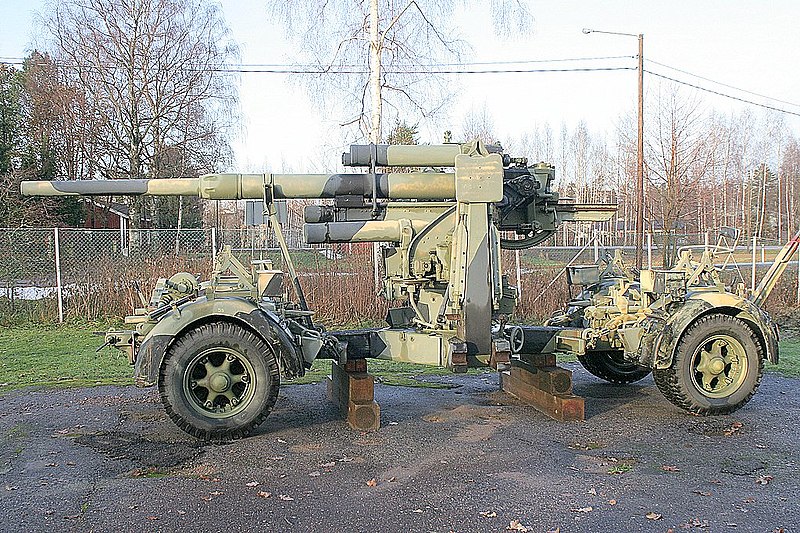GERMAN 88mm GUN

Specifically, the Flug abwehr-Kanone, or FlaK, 36 mounted to a Sonderanhaenger 201 trailer towed by a heavy tractor --- usually the SdKfz 7 half-track built by Krauss-Maffei. 8.8 cm FlaK 36 Entered service 1936-37. The earlier FlaK 18 was fielded in 1928, and the 88mm shell goes back to 1916 as an anti-aircraft shell. Most FlaK 18's were retrofitted with the 201 trailer and other FlaK 36 features.
The redesigned trailer Sonderanhänger 201 enabling faster time to action from the move. Could engage ground targets from its travelling position. Weight 7 tonnes. Rate of fire 15 to 20 rounds per minute. Produced by Krupp.
The eighty-eight was used in two roles: as a mobile heavy anti-aircraft gun, and in a more static role for home defense. In this latter role the guns were arranged into large batteries, directed by a single controller, and were moved only rarely.
Both the Flak 18 and Flak 36 had a high angle range of 35,100 ft.and a horizontal range of 16,200 yards. They could fire high explosive (HE), armour piercing (AP) or smoke shells. The weight of the projectile was 20 lbs. (HE) or 21 lbs. (AP and smoke). Muzzle velocity was 2690 ft. per second with HE and 2620 ft.with AP.
With APCBC, it could penetrate 130 mm of armour at 1500 yards.
Rate of fire 15 to 20 rounds per minute.
The crew was 11 men, consisting of layer, trainer, breechworker, fuse setter, and five ammunition supply numbers, plus the detachment commander and the tractor driver. When firing against ground targets two ammunition numbers became the range and deflection setters respectively, and the fuse setter became an ammunition number. The senior ammunition number was in charge of ammunition supply and was the detachment second-in-command.
There were tree methods of fire control, by radar or predictor though a data transmission system for AA fire, direct laying through the sights for the anti-tank role, and indirect fire in conjunction with a range-finder.
8.8 cm KwK 36 L/56.
Overall Lenght including muzzle brake:
17 ft. 15½ in.
APCBC Shell: 21 lb MV 2600 fps.
AP40 Shot: 16 lb MV 3070 fps.
HE Shell: 20 lb MV 2690 fps.
Combat HistoryFlak 36s made their debut in the notorious anti-tank role at Halfaya during the Battle of Sollum, June 1941. Firing from concealed positions at short range, they destroyed 123 out of 238 attacking British tank. The Germans claimed on British tank for every 20 "88" rounds fired at Halfaya.
Envisoned in-game:Artillery has historically been known as the "King of the Battlefield" yet remains unrepresented in AHII. GV's in-game have up till now only had the Tiger tank with which to spend perk points, and some fighter pilots complain about their inability to detect and intercept high level bombers attacking their field, or heavy bombers attacking at tree top level.
The 88mm had a devastating impact on the battlefield, and should carry with it a high perk cost, so as to not see an overuse of it in the arena. Conversely, the system would be defensively weak as compared to tanks and armored vehicles in game due to exposed crew.
Limitations:
It would not very maneuverable or fast since the trailer and track combination are not speedy over open ground. The tractor/trailer arrangement with exposed troops manning it would be very vulnerable to incoming fire of any kind, slow traverse would not be very effective at close-in targets. High perk cost. Since code does not incorporate a tractor-trailer pivot point, the visual movement of the system will suffer (more resembling a long fire truck probably).... as would maneuverability in tight areas and over hills.
Advantages:
Effective in defense to "snipe" at long range, bombard towns in offense, and force buffs to higher altitudes. Gives the GVr's another vehicle to spend GV perks on, forces bombers off the deck. Way to defend spawn points.
The AA FlaK's used central firing control to dictate fuse settings on shells based on altitude and speed. The command would come down, and the shells would be set before loading and firing. In-game we have single players controlling these systems, and the code already exists for the 5-inch guns and puffy ack guns, so it would make more sense to use existing code to develop the 88mm cannon where possible.
Pic of FlaK-18 firing.
